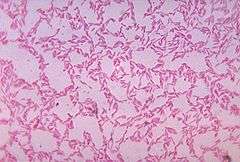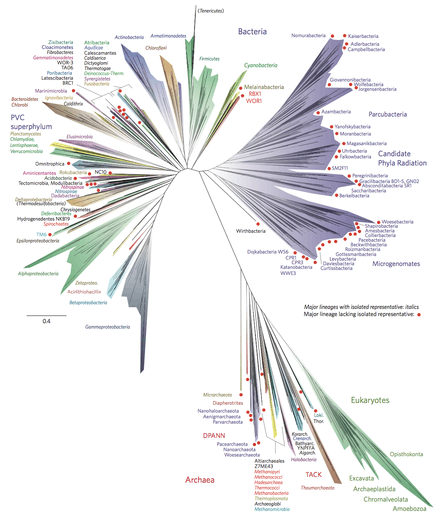Sphingobacteria (phylum)
The FCB group is a superphylum of bacteria named after the main member phyla Fibrobacteres, Chlorobi, and Bacteroidetes. The members are considered to form a clade due to a number of conserved signature indels.[3]
| FCB group | |
|---|---|
 | |
| Bacteroides spp. | |
| Scientific classification | |
| Domain: | |
| (unranked): | |
| Superphylum: | FCB group |
| Phyla | |
| |
| Synonyms | |
|
Sphingobacteria Cavalier-Smith, 1987[1] | |

The Bacteroidetes-Chlorobi group in brown is visible on this 2016 tree of life using ribosomal protein sequences[2]
Cavalier-Smith calls the equivalent grouping a phylum by the name of Sphingobacteria. It contains the classes Chlorobea (= Chlorobi), Fibrobacteres, Bacteroidetes[lower-alpha 1] and Flavobacteria. However, this megaclassification is not followed by the larger scientific community.[4][5][6]
| FCB group[3] | ||||||||||||
|
An analogous situation is seen with the PVC group/Planctobacteria.
Notes
- Different from the accepted Bacteroidetes, which consists of Bacteroidia (equivalent to Cavalier-Smith's Bacteroidetes), Cytophagia and Flavobacteriia and Sphingobacteriia.
gollark: Unfortunately, my powers of TV watching do not extend to time compression.
gollark: No, I've *started* watching it today and am up to episode 4 season 1.
gollark: People make that mistake, but I am not working for pizza companies doing subliminal advertising; that is not in any way what I am doing.
gollark: I finally got round to watching The Expanse (TV show) and it's very good, don't really know why I didn't earlier.
gollark: I don't think I even got that to work, and pins just moving around a bit and not doing much was not very encouraging.
References
- Cavalier-Smith, T. (1987). The origin of cells: a symbiosis between genes, catalysts and membranes. Cold Spring Harbor Symposia on Quantitative Biology 52, 805-24, , .
- Hug, Laura A.; Baker, Brett J.; Anantharaman, Karthik; Brown, Christopher T.; Probst, Alexander J.; Castelle, Cindy J.; Butterfield, Cristina N.; Hernsdorf, Alex W.; Amano, Yuki; Ise, Kotaro; Suzuki, Yohey; Dudek, Natasha; Relman, David A.; Finstad, Kari M.; Amundson, Ronald; Thomas, Brian C.; Banfield, Jillian F. (11 April 2016). "A new view of the tree of life". Nature Microbiology. 1 (5): 16048. doi:10.1038/nmicrobiol.2016.48. PMID 27572647.
- Gupta, R. S. (2004). "The Phylogeny and Signature Sequences Characteristics of Fibrobacteres, Chlorobi, and Bacteroidetes". Critical Reviews in Microbiology. 30 (2): 123–143. doi:10.1080/10408410490435133. PMID 15239383.
- Cavalier-Smith T (2006). "Rooting the tree of life by transition analyses". Biol. Direct. 1: 19. doi:10.1186/1745-6150-1-19. PMC 1586193. PMID 16834776.
- Krieg, N.R.; Ludwig, W.; Whitman, W.B.; Hedlund, B.P.; Paster, B.J.; Staley, J.T.; Ward, N.; Brown, D.; Parte, A. (November 24, 2010) [1984(Williams & Wilkins)]. George M. Garrity (ed.). The Bacteroidetes, Spirochaetes, Tenericutes (Mollicutes), Acidobacteria, Fibrobacteres, Fusobacteria, Dictyoglomi, Gemmatimonadetes, Lentisphaerae, Verrucomicrobia, Chlamydiae, and Planctomycetes. Bergey's Manual of Systematic Bacteriology. 4 (2nd ed.). New York: Springer. p. 908. ISBN 978-0-387-95042-6. British Library no. GBA561951.
- Classification entry in LPSN [Euzéby, J.P. (1997). "List of Bacterial Names with Standing in Nomenclature: a folder available on the Internet". International Journal of Systematic and Evolutionary Microbiology. 47 (2): 590–2. doi:10.1099/00207713-47-2-590. PMID 9103655.]
This article is issued from Wikipedia. The text is licensed under Creative Commons - Attribution - Sharealike. Additional terms may apply for the media files.